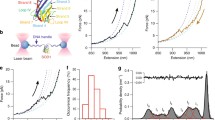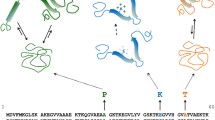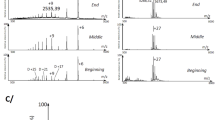Abstract
Many neurodegenerative diseases feature misfolded proteins that propagate via templated conversion of natively folded molecules. However, crucial questions about how such prion-like conversion occurs and what drives it remain unsolved, partly because technical challenges have prevented direct observation of conversion for any protein. We observed prion-like conversion in single molecules of superoxide dismutase-1 (SOD1), whose misfolding is linked to amyotrophic lateral sclerosis. Tethering pathogenic misfolded SOD1 mutants to wild-type molecules held in optical tweezers, we found that the mutants vastly increased misfolding of the wild-type molecule, inducing multiple misfolded isoforms. Crucially, the pattern of misfolding was the same in the mutant and converted wild-type domains and varied when the misfolded mutant was changed, reflecting the templating effect expected for prion-like conversion. Ensemble measurements showed decreased enzymatic activity in tethered heterodimers as conversion progressed, mirroring the single-molecule results. Antibodies sensitive to disease-specific epitopes bound to the converted protein, implying that conversion produced disease-relevant misfolded conformers.







Similar content being viewed by others
Data availability
Data supporting this work have been deposited on Figshare (https://doi.org/10.6084/m9.figshare.25751289; ref. 51). Source data are provided with this paper.
References
Chiti, F. & Dobson, C. M. Protein misfolding, amyloid formation, and human disease: a summary of progress over the last decade. Annu. Rev. Biochem. 86, 27–68 (2017).
Colby, D. W. & Prusiner, S. B. Prions. Cold Spring Harb. Perspect. Biol. 3, a006833 (2011).
McAlary, L., Plotkin, S. S., Yerbury, J. J. & Cashman, N. R. Prion-like propagation of protein misfolding and aggregation in amyotrophic lateral sclerosis. Front. Mol. Neurosci. 12, 262 (2019).
Vaquer-Alicea, J. & Diamond, M. I. Propagation of protein aggregation in neurodegenerative diseases. Annu. Rev. Biochem. 88, 785–810 (2019).
Jahn, T. R. & Radford, S. E. Folding versus aggregation: polypeptide conformations on competing pathways. Arch. Biochem. Biophys. 469, 100–117 (2008).
Yu, H. et al. Protein misfolding occurs by slow diffusion across multiple barriers in a rough energy landscape. Proc. Natl Acad. Sci. USA 112, 8308–8313 (2015).
Hoffmann, A., Neupane, K. & Woodside, M. T. Single-molecule assays for investigating protein misfolding and aggregation. Phys. Chem. Chem. Phys. 15, 7934–7948 (2013).
Wu, J., Cao, C., Loch, R. A., Tiiman, A. & Luo, J. Single-molecule studies of amyloid proteins: from biophysical properties to diagnostic perspectives. Q. Rev. Biophys. 53, e12 (2020).
Prudencio, M., Durazo, A., Whitelegge, J. P. & Borchelt, D. R. An examination of wild-type SOD1 in modulating the toxicity and aggregation of ALS-associated mutant SOD1. Hum. Mol. Genet. 19, 4774–4789 (2010).
Grad, L. I. et al. Intermolecular transmission of superoxide dismutase 1 misfolding in living cells. Proc. Natl Acad. Sci. USA 108, 16398–16403 (2011).
Woo, T.-G. et al. Novel chemical inhibitor against SOD1 misfolding and aggregation protects neuron-loss and ameliorates disease symptoms in ALS mouse model. Commun. Biol. 4, 1397 (2021).
Lindberg, M. J., Normark, J., Holmgren, A. & Oliveberg, M. Folding of human superoxide dismutase: Disulfide reduction prevents dimerization and produces marginally stable monomers. Proc. Natl Acad. Sci. USA 101, 15893–15898 (2004).
Lindberg, M. J., Byström, R., Boknäs, N., Andersen, P. M. & Oliveberg, M. Systematically perturbed folding patterns of amyotrophic lateral sclerosis (ALS)-associated SOD1 mutants. Proc. Natl Acad. Sci. USA 102, 9754–9759 (2005).
Proctor, E. A., Ding, F. & Dokholyan, N. V. Structural and thermodynamic effects of post-translational modifications in mutant and wild type Cu, Zn superoxide dismutase. J. Mol. Biol. 408, 555–567 (2011).
Sen Mojumdar, S. et al. Partially native intermediates mediate misfolding of SOD1 in single-molecule folding trajectories. Nat. Commun. 8, 1881 (2017).
Broom, H. R., Rumfeldt, J. A. O., Vassall, K. A. & Meiering, E. M. Destabilization of the dimer interface is a common consequence of diverse ALS-associated mutations in metal free SOD1. Protein Sci. 24, 2081–2089 (2015).
Hörnberg, A., Logan, D. T., Marklund, S. L. & Oliveberg, M. The coupling between disulphide status, metallation and dimer interface strength in Cu/Zn superoxide dismutase. J. Mol. Biol. 365, 333–342 (2007).
Petrosyan, R., Narayan, A. & Woodside, M. T. Single-molecule force spectroscopy of protein folding. J. Mol. Biol. 433, 167207 (2021).
Furukawa, Y. & O’Halloran, T. V. Amyotrophic lateral sclerosis mutations have the greatest destabilizing effect on the apo- and reduced form of SOD1, leading to unfolding and oxidative aggregation. J. Biol. Chem. 280, 17266–17274 (2005).
Oztug Durer, Z. A. et al. Loss of metal ions, disulfide reduction and mutations related to familial ALS promote formation of amyloid-like aggregates from superoxide dismutase. PLoS ONE 4, e5004 (2009).
Andersen, P. M. et al. Phenotypic heterogeneity in motor neuron disease patients with CuZn–superoxide dismutase mutations in Scandinavia. Brain 120, 1723–1737 (1997).
Juneja, T., Pericak-Vance, M. A., Laing, N. G., Dave, S. & Siddique, T. Prognosis in familial amyotrophic lateral sclerosis. Neurology 48, 55–57 (1997).
Rodriguez, J. A. et al. Familial amyotrophic lateral sclerosis-associated mutations decrease the thermal stability of distinctly metallated species of human copper/zinc superoxide dismutase. J. Biol. Chem. 277, 15932–15937 (2002).
Borchelt, D. R. et al. Superoxide dismutase 1 with mutations linked to familial amyotrophic lateral sclerosis possesses significant activity. Proc. Natl Acad. Sci. USA 91, 8292–8296 (1994).
Jonsson, P. A. et al. Minute quantities of misfolded mutant superoxide dismutase-1 cause amyotrophic lateral sclerosis. Brain 127, 73–88 (2004).
Weydert, C. J. & Cullen, J. J. Measurement of superoxide dismutase, catalase and glutathione peroxidase in cultured cells and tissue. Nat. Protoc. 5, 51–66 (2010).
Rakhit, R. et al. An immunological epitope selective for pathological monomer-misfolded SOD1 in ALS. Nat. Med. 13, 754–759 (2007).
Atlasi, R. S. et al. Investigation of anti-SOD1 antibodies yields new structural insight into SOD1 misfolding and surprising behavior of the antibodies themselves. ACS Chem. Biol. 13, 2794–2807 (2018).
Asor, R. & Kukura, P. Characterising biomolecular interactions and dynamics with mass photometry. Curr. Opin. Chem. Biol. 68, 102132 (2022).
Meisl, G., Knowles, T. P. & Klenerman, D. The molecular processes underpinning prion-like spreading and seed amplification in protein aggregation. Curr. Opin. Neurobiol. 61, 58–64 (2020).
Griffith, J. S. Nature of the scrapie agent: self-replication and scrapie. Nature 215, 1043–1044 (1967).
Prusiner, S. B. Novel proteinaceous infectious particles cause scrapie. Science 216, 136–144 (1982).
Scialò, C., De Cecco, E., Manganotti, P. & Legname, G. Prion and prion-like protein strains: deciphering the molecular basis of heterogeneity in neurodegeneration. Viruses 11, 261 (2019).
Soto, C. & Pritzkow, S. Protein misfolding, aggregation, and conformational strains in neurodegenerative diseases. Nat. Neurosci. 21, 1332–1340 (2018).
Li, J., Browning, S., Mahal, S. P., Oelschlegel, A. M. & Weissmann, C. Darwinian evolution of prions in cell culture. Science 327, 869–872 (2010).
Bergh, J. et al. Structural and kinetic analysis of protein-aggregate strains in vivo using binary epitope mapping. Proc. Natl Acad. Sci. USA 112, 4489–4494 (2015).
Sekhar, A. et al. Thermal fluctuations of immature SOD1 lead to separate folding and misfolding pathways. eLife 4, e07296 (2015).
Luchinat, E. et al. In-cell NMR reveals potential precursor of toxic species from SOD1 fALS mutants. Nat. Commun. 5, 5502 (2014).
Stevens, J. C. et al. Modification of superoxide dismutase 1 (SOD1) properties by a GFP tag–implications for research into amyotrophic lateral sclerosis (ALS). PLoS ONE 5, e9541 (2010).
Rotunno, M. S. et al. Identification of a misfolded region in superoxide dismutase 1 that is exposed in amyotrophic lateral sclerosis. J. Biol. Chem. 289, 28527–28538 (2014).
Bruns, C. K. & Kopito, R. R. Impaired post-translational folding of familial ALS-linked Cu, Zn superoxide dismutase mutants. EMBO J. 26, 855–866 (2007).
Crown, A. et al. Tryptophan residue 32 in human Cu–Zn superoxide dismutase modulates prion-like propagation and strain selection. PLoS ONE 15, e0227655 (2020).
Gupta, A. N. et al. Pharmacological chaperone reshapes the energy landscape for folding and aggregation of the prion protein. Nat. Commun. 7, 12058 (2016).
Mashaghi, A., Kramer, G., Lamb, D. C., Mayer, M. P. & Tans, S. J. Chaperone action at the single-molecule level. Chem. Rev. 114, 660–676 (2014).
Mitsumoto, H. et al. Quantitative objective markers for upper and lower motor neuron dysfunction in ALS. Neurology 68, 1402–1410 (2007).
Walder, R. et al. Rapid characterization of a mechanically labile α-helical protein enabled by efficient site-specific bioconjugation. J. Am. Chem. Soc. 139, 9867–9875 (2017).
Liang, Y. & Fu, G. C. Catalytic asymmetric synthesis of tertiary alkyl fluorides: Negishi cross-couplings of racemic α,α-dihaloketones. J. Am. Chem. Soc. 136, 5520–5524 (2014).
Neuman, K. C. & Block, S. M. Optical trapping. Rev. Sci. Instrum. 75, 2787–2809 (2004).
Wang, M. D., Yin, H., Landick, R., Gelles, J. & Block, S. M. Stretching DNA with optical tweezers. Biophys. J. 72, 1335–1346 (1997).
Paul, S. S., Lyons, A., Kirchner, R. & Woodside, M. T. Quantifying oligomer populations in real time during protein aggregation using single-molecule mass photometry. ACS Nano 16, 16462–16470 (2022).
Neupane, K., Narayan, A., Sen Mojumdar, S. & Woodside, M.T. Single-molecule force spectroscopy data for prion-like conversion of wild-type SOD1 by pathogenic mutants G127X and G85R. Figshare https://doi.org/10.6084/m9.figshare.25751289
Acknowledgements
We thank N. Cashman (University of British Columbia, Canada) for helpful discussions and for providing antibody samples. This work was supported by the Alberta Prion Research Institute (grant 201600020), Canadian Institutes of Health Research (grant PJT-185931), Natural Sciences and Engineering Research Council Canada (grant RGPIN-2018-04673) and National Research Council Canada. A.N. acknowledges support from a Banting Postdoctoral Fellowship and an Alberta Innovates Postdoctoral Fellowship. G.A. acknowledges support from an Alberta Innovates studentship.
Author information
Authors and Affiliations
Contributions
K.N., A.N., S.S.M. and M.T.W. designed the research. K.N., A.N. and C.R.G. provided reagents. K.N., A.N., S.S.M. and G.A. performed experiments. K.N. and A.N. analyzed data. A.N. and M.T.W. wrote the manuscript. All authors edited the manuscript.
Corresponding author
Ethics declarations
Competing interests
The authors declare no competing interests.
Peer review
Peer review information
Nature Chemical Biology thanks Gregory Merz, Tae-Young Yoon and Yongli Zhang for their contribution to the peer review of this work.
Additional information
Publisher’s note Springer Nature remains neutral with regard to jurisdictional claims in published maps and institutional affiliations.
Extended data
Extended Data Fig. 1 Unfolding force distributions for native and misfolded states.
The distribution of unfolding forces for the native state (black) is similar to the distribution of unfolding forces seen for all misfolded states (red).
Extended Data Fig. 2 Sample unfolding FECs for G127X mutant.
Examples of unfolding curves for the misfolded G127X mutant showing total length changes of different amounts, reflecting different misfolded states.
Extended Data Fig. 3 Effect of chemical denaturant and reducing agent on conversion.
WST-1 formazan production by superoxide ions is normally inhibited by SOD1 activity; the drop in inhibition by SOD1 indicates that the enzyme becomes less active owing to conversion. (A) As the amount of chemical denaturant (GdnHCl) used to destabilize SOD1 is reduced from 1 M, the lag phase for conversion increases, until at 0 M no conversion is detected after 10 days. In each measurement, 5 mM TCEP was also present. (B) In the absence of any TCEP, but with 1 M GdnHCl, no conversion is detected after 10 days. All measurements were done using wt-G85R heterodimer. Error bars represent s.e.m. from 3 replicates.
Extended Data Fig. 4 Detection of disease-specific misfolded epitopes in converted wt SOD1.
Mass spectra from single-molecule mass photometry of (A) antibody 10C12 (sensitive specifically to disease-related misfolded C-terminal residues) and (B) 10C12 with wt-G127X heterodimer before conversion show distinct peaks for unbound antibody (dotted yellow line) and heterodimer (dotted gray line). (C) After 48 h conversion in the ensemble assay, the heterodimer peak is smaller and the antibody peak shifts. (D) Difference spectrum before and after conversion shows a decrease in unbound antibody and heterodimer and formation of a new peak at the mass of the bound complex.
Supplementary information
Supplementary Information
Supplementary Tables 1 and 2 and Supplementary Figs. 1–3.
Supplementary Data 1
Supporting data for Supplementary Figs. 1–3.
Source data
Source Data Fig. 1
Statistical source data.
Source Data Fig. 2
Statistical source data.
Source Data Fig. 3
Statistical source data.
Source Data Fig. 4
Statistical source data.
Source Data Fig. 5
Statistical source data.
Source Data Extended Data Fig. 1
Statistical source data.
Source Data Extended Data Fig. 2
Statistical source data.
Source Data Extended Data Fig. 3
Statistical source data.
Source Data Extended Data Fig. 4
Statistical source data.
Rights and permissions
Springer Nature or its licensor (e.g. a society or other partner) holds exclusive rights to this article under a publishing agreement with the author(s) or other rightsholder(s); author self-archiving of the accepted manuscript version of this article is solely governed by the terms of such publishing agreement and applicable law.
About this article
Cite this article
Neupane, K., Narayan, A., Sen Mojumdar, S. et al. Direct observation of prion-like propagation of protein misfolding templated by pathogenic mutants. Nat Chem Biol 20, 1220–1226 (2024). https://doi.org/10.1038/s41589-024-01672-8
Received:
Accepted:
Published:
Issue Date:
DOI: https://doi.org/10.1038/s41589-024-01672-8
- Springer Nature America, Inc.





